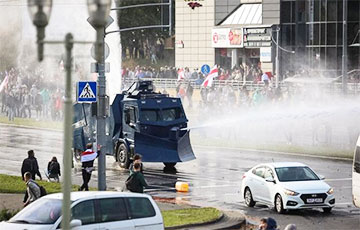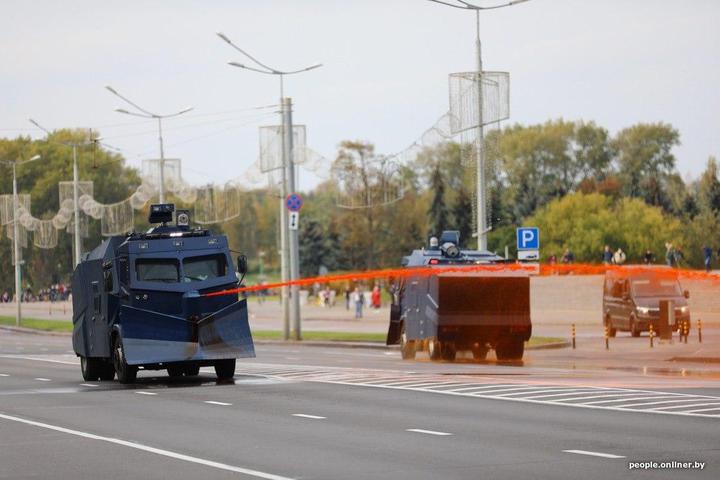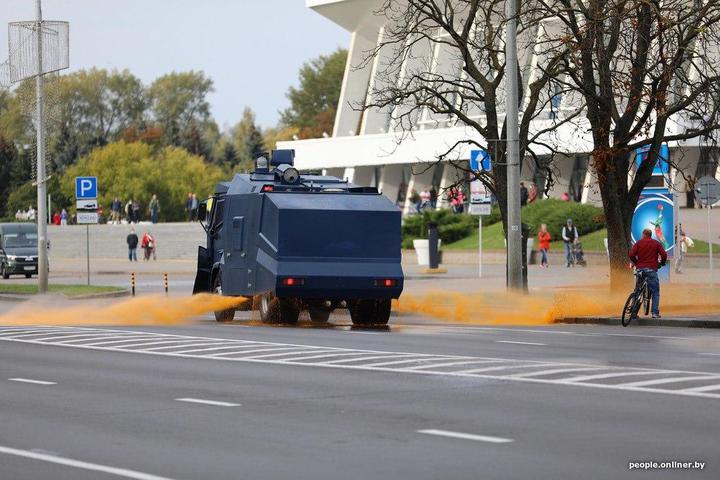What Happened to the Predator Water Cannons During the Protests in Minsk?
57- 6.10.2020, 15:54
- 93,209

The armored vehicle proved to be easy to disable with bare hands.
The Predator water cannons became widely known thanks to the Belarusian protest. A recognizable profile with a sharp blade, orange water on the heads of protesters, nominally enormous power that can "drill" barricades, armor that allows you to even hold rifle bullets. However, this Sunday in Minsk, the water cannons appeared in a new light: one of them threw a jet into the sky like a whale, and shots were circulated on the Web showing a certain detail being pulled out of a water cannon.
The tut.by portal tried to figure out what exactly happened to the Predators on October 4.
Water cannon near the Sports Palace: dispersal of protesters
To begin with, we will restore the chronology of the movement of water cannons in Minsk this Sunday - this will help determine when and what exactly happened to the cars.
So, at about 15 o'clock on October 4, a water cannon drove to Peramozhtsau Avenue near the Sports Palace and began to pour water jets on the crowd gathering here. Unlike the dispersal of spontaneous protests after the inauguration, the Predator was no longer working as a canopy - the jets hit the protesters, and the water was ordinary, not orange.
Obviously, there was no purpose to "mark" the demonstrators: the security forces were working to disperse them. For a while, this was successful: people who were gathering to the stele "Minsk - Hero City" were not allowed to see it and were not allowed to unite with the protesters already there. The car was accompanied by security officials in minibuses.
The same water cannon on Masherava: an umbrella and a spectacular fountain
Then the water cannon turned in the stele's direction and continued to water people already on Masherava Avenue, moving towards the Crown mall.
On the way to Peramozhtsau Avenue, it sent a jet at a man who hid behind an umbrella. After that, water splashed from the bottom of the Predator in all directions at once; then, the water cannon was enveloped in a spray of liquid, which was already beating from the upper part of the body.
After returning to the stele, the car turned onto Masherava, where it again began to spray the protesters. And then trouble happened to the "Predator": first, a young man ran up to him from the left, opened the door, and took from the inside an object that looked like a fire hydrant (some readers suggested that it was a hydrant column), and a canister - apparently with orange dye for water tint. And almost immediately, an unknown person from the right ran up to the water cannon, also opened the door, and did something inside the body.
A few seconds later, a powerful fountain of water erupted from the roof of the car, and the "Predator" himself rushed under the cover of a cordon of security officials, whom he eventually doused instead of the protesters.
However, the malfunction was eliminated, and after a while, the water cannon began to water again, being covered on both sides by the AMAP formation - however, unlike its first "raid" to the Sports Palace, it did not achieve any significant results.
Two water cannons on Peramozhtsau Avenue: orange water again
The next use of Predators was an hour later, again, in the Sports Palace area; this time, two water cannons worked at once. The water gushing out of them was already tinted in familiar to us orange color, which can be seen in the photo of our colleague from Onliner.


One of them sprayed liquid in the same way as after the inauguration: the jet beat from the pump forward. The second sprayed from pipes in the lower part of the body on both sides of the machine simultaneously. Apparently, the security forces again tried to mark the protesters with dye (which, by the way, were no longer in this area by 4 pm, the columns had by that time reached the Pushkinskaya metro station).
We figure out what happened to the water cannon on Peramozhtsau and Masherava
Initially, information circulated on the Web that the Predator, which was watering a man with an umbrella, suddenly broke down, and because of this, the water went down. This is not the case: water cannons of this class have a "close combat" mode, when pipes begin to release water from the lower or upper part of the hull in order to push back the protesters who surrounded the car. True, in this case, there was almost no one around the water cannon, so the effectiveness of such an action seems a little doubtful.
Let's move on to the Masherava incident. Again, after the spectacular fountain, many Internet users decided that the "hydrant" "torn out" from the left side of the car caused damage to the system, which made the water cannon look like a whale. Some even thought it was the "kidnapping" of a paint canister from the car that led to this.
After examining everything possible, we came to the conclusion that this is not the case.
Firstly, most likely, neither the hydrant column nor the canister were torn out at all: at the moment, when the left door of the water cannon was opened, these elements were not attached to anything. The automobile piston compressor fire column (or something extremely reminiscent of it), which was taken from the Predator, has nothing to do with the actual water cannon system; it is needed, for example, to replenish water for a water cannon from a water supply system through an ordinary fireman sleeve. Accordingly, the column cannot be considered a part of the Predator at all and is not integrated into any of its systems.
As for the paint canister, the situation is as follows. Pouring the dye into the main tank can damage it (it would be a torture to wash such a whopper), so the dye is usually contained in smaller tanks (usually there are two or three of them, 20-30 liters each) and is mixed with water already during the spraying process. Such tanks are replenished from canisters. Accordingly, the canister itself, again, is never integrated into any of the Predator's systems and cannot be considered a part of it.
But the door on the right is much more interesting. As far as we know (of course, this is an assumption, no one has ever published the exact design of the Predator made for Belarus), it is on the right side where access to the water supply systems is carried out, and there are also hydraulic pumps. We assumed that the protester tore out the hydraulic pump, after which the system began to malfunction, and the jet from the Predator began to beat through the upper hatch. This was later confirmed by the Ministry of Internal Affairs: they say, a 27-year-old resident of the Stolin district (now already detained) tore out the hydraulic pumps from the water cannon.
For Predators, which poured orange water at 16 o'clock at the Sports Palace from the lower part of the hull, this is not the result of a product breakdown but one of the water cannon modes.
Why was the protected machine easy to open by hand?

It is known that the Predator is armored according to the fourth class (this is the old classification, now it's the fifth one) and allows to "hold" 7.62 × 51 rifle bullets. However, on October 4, the water cannon was opened from both sides simply by hand. Why is that?
Obviously, the reason lies in the peculiarities of the tactical use of Predators. In a normal situation, the water cannon is covered on both sides by a phalanx with shields or a formation without them, so it is impossible to get close to it. And the ease of opening the doors is needed so that the service personnel can refuel or repair the car without interference.
What other interesting things we learned
Trying to determine the water cannon's design from the available information, we are highly likely to calculate the chassis on which the Predator is built. Until that time, it was only known that the car was assembled on an Iveco chassis. However, there are at least 77 known such models. Let's figure it out.
We know from numerous photos and videos of water cannons in Minsk that a water cannon has four wheels. At the same time, the rear tires are gable (two on each side), the front - single-pitched. Using the elimination method, we concluded that, with a high degree of probability, the Predator was assembled on the Eurocargo ML150E22H-4185 chassis with a 4 × 2 wheel arrangement. The carrying capacity of such a chassis is approximately 9.7 tons. 6.5 tons of them are water (we remember that the capacity of the Predator's tank is declared at 6500 liters, and a liter of water weighs exactly a kilogram). True, the manufacturer's website indicates that only 5000 liters of water can be placed in the tank. But it is worth remembering that Predator is a piece product, not a serial stamping, so that individual parts (tank, dump) can be made on order (on the same manufacturer's website you can see photos of water cannons, the dumps of which do not at all resemble those which are used in Belarus).

So, 6.5 tons of payload have already been "taken" by water. Further, the design of the special equipment itself includes sprayers, pump, blade, hydraulics, optics, body (the weight of the chassis itself is not counted, it is not included in the payload). For the water pump's operation, apparently, a separate engine is responsible - again, it has weight. Together, this will pull in no less than three tons.
We wrote above that the water cannon is armored against 7.62 × 51 bullets. But the armor also weighs a lot! Taking into account the dimensions of the product, the armor protection for only one side, according to estimates (taking into account the length and height of the sides), should weight about 800 kg; for two sides, it will be 1.6 tons. Add the front, rear, and roof protection (which has a larger area than the front and rear of the car combined). As a result, it turns out that the Predator's chassis would be rather heavily overloaded with the specified carrying capacity.
Moreover, steel armor cannot protect the window. The triplexes made of bulletproof glass that "hold" the bullets are usually quite thick: so that in order to "hold" a 7.62 × 51 bullet, the window must be made of 6a class bulletproof glass 6.85 cm thick. The Predator does not have thick windows; they would give the car a slightly different look. Therefore, the question of how exactly the car is armored remains open.
Another issue is the pressure generated by the pumps. Previously, it was believed that the German company Siegler supplied the Predators with pumps with a pressure of 20 bar (or technical atmospheres). However, we did not find a single model on the company's website that produces more than 15 bar. It's still quite a lot: such pumps are put on water cannons in Germany. Perhaps the more powerful 20 bar models have already ceased to be produced.










